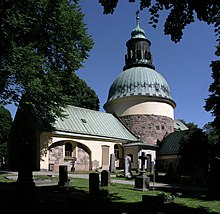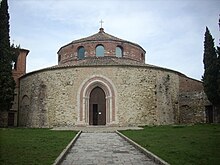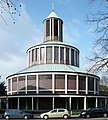Round church
The round church is a special feature of church building history, in which the interior, in contrast to the longitudinal building or the cross-shaped church, has an essentially circular floor plan .
The round church is a form of the simple central building . It used to be used as a baptismal , burial or fortified church . Any additions such as apses , portico (vestibule), side chapels or sacristy are not part of the actual church space and do not significantly change the character of the round church.

Prehistory and History
Europe and Levant
The oldest round buildings are open Neolithic temples, as they are known from Göbekli Tepe and were found in Jerf el Ahmar in the Levant ; also Stonehenge , its wooden predecessor and other megalithic stone circles ( cromlechs ) are circular buildings. The idea of the round temple disappeared for a while, only to reappear, for example, as Clava Cairn or Tholos . Often only foundations can be found, as in Agrigento in Sicily as well as in Sardinia and the Balearic Islands . From the Bronze Age , the remains are a little more extensive. Round buildings such as the Irish duns or the Scottish wheelhouses are evidence of the continued existence of the idea, as do the Sardinian nuraghi . During the Iron Age, the beehive huts and the Swedish fortresses were added. In Rome the Temple of Vesta was built on the Tiber .
It can be assumed that the idea of the round church emerged as a formal takeover of pre-Christian cult structures such as the Tholoi and Monopteroi . Especially in early Christian times and in the Middle Ages, this design was occasionally able to hold its own against the Christian cross basilica . The oldest Christian round church is said to be the Holy Sepulcher in Jerusalem (c. 335 AD). In the following years, Christian round churches appear mainly in the form of country, baptismal, fortified and grave churches or palace chapels. The church of Sv. Donat in Zadar dates from the 9th century.

Georgia and Armenia
There are some outstanding examples of four- conch and six-conch buildings in medieval Georgian and Armenian church architecture , in which the corresponding number of semicircular apses are arranged around a central domed hall. Outside it is surrounded by a circular gallery. The Armenian cathedral of Zvartnots from the 7th century and the Georgian round church of Bana , built around 900, have been preserved in ruins . Armenian round churches in Ani date from the 10th and 11th centuries.
Ethiopia
In Ethiopia the round church has prevailed since the 16th century and is today the characteristic form of church construction. On the outside, these churches look like large tukuls (classic round huts), inside they are usually divided into three areas: The Kene Mahalet , the Mäkdas and the Kedus Kedusan .
The Kene Mahalet is a tour in the outer area, which is separated from the two inner sections by a wall. It can be entered by anyone, the floor is covered with carpets and there are chairs for the elderly and children in the entrance area (the Ethiopian Orthodox service is celebrated standing). In the second area, the Mäkdas , only the priests are allowed to enter through doors. The church drums ( kebero ) and sistras for worship are kept there. The floor is also covered with carpets. The Kedus Kedusan is the holy of holies. It is rectangular and includes the altar and tabot , a replica of the ark made of wood. All walls are painted with ornaments and images of saints.
Related terms
Rotunda
Rotunda is the name for a building with a circular floor plan or for a round architectural element. It is also the name for early round church buildings in Italy, France, Bohemia and Moravia, up to around the 12th century. A rotunda either stands alone ( central building ) or is part of a non-rounded overall concept ( St. Peter's Basilica ).
In some cases, large, especially baroque central buildings are not referred to as round churches if they are not of the baptismal, burial or fortified church type.
Examples:
- Charroux Abbey (Poitou)
- Ste-Marie de Lanleff (Brittany)
- Saint Hedwig's Cathedral in Berlin
- Santa Maria della Salute in Venice
Oval churches
Church buildings with an oval floor plan are often referred to as round churches .
Examples
- Chapel of Reconciliation on the former Berlin “ death strip ” on Bernauer Strasse
- Reformed Church of Chêne-Pâquier in the canton of Vaud , Switzerland
Octagons
Well-known octagons (such as Aachen Cathedral ) are sometimes incorrectly referred to as round churches.
Constantine I began building the first octagonal church, the Domus Aurea, in Antioch in AD 327 . There are architectural encyclopedias that expressly allow the designation "round church" in these cases.
Octagonal round churches:
- Aachen Cathedral
- Chapel of Grace in Altötting
- Trinitatiskirche Carlsfeld / Erzgebirge
- Evangelical Lutheran Church in Seiffen / Erzgebirge
- Church of the Prince of Peace in Klingenthal
Dodecagonal buildings
Churches with a twelve-sided floor plan are also in the tradition of the round church.
- Drüggelter Chapel , Möhnesee , Delecke district, Sauerland , 12th century
- Santa María de Eunate , near Puente la Reina , Navarra on the Spanish Way of St. James
- La Vera Cruz in Segovia , 13th century with a three-apse choir
Three icon system
The Dreifaltigkeitskirche Kappl in Waldsassen has a triangular floor plan (triangular arrangement ) .
Vierpasskirche
The Jesus Chapel in Odorheiu Seguiesc ( Oderhellen ) in Transylvania, probably from the 13th century, has a floor plan of four circles (Vierpass) .
Round churches in the narrower sense
Early Christian time
- Santo Stefano Rotondo (5th century), Rome
- San Michele Arcangelo (5th / 6th century), Perugia
middle Ages
Bulgaria
- Round Church of Preslaw , 10th century
Germany
- Altenfurt (Nuremberg), Chapel of John the Baptist and Catherine , 12th century
- Eisenharz (Allgäu), round chapel
- Hausbach (Vilshofen an der Donau) , St. Magdalena , Romanesque round church with Gothic vaults
- Knautnaundorf (Leipzig), Andreas Chapel , before 1100
- Oeversee (Flensburg district), St. Georg Church , 12th century
- Salzfurt Chapel (Saxony-Anhalt), round church , 12th century
- Würzburg , Marienkirche ; 8th or 10th century
No longer preserved or are in ruins:
- Round chapel of Burg Höfe , Hesse, 8./9. Century (archaeological)
- Round chapel (rotunda), Wiprechtsburg Groitzsch , Saxony, around 1080 (ruin)
- St. Michaelis monastery church in Schleswig, 12th century (replaced by a new building in 1870)
- Remains / foundation walls of a Romanesque round chapel (rotunda) in the cemetery of the Petersberg monastery , Saxony-Anhalt
England
Examples of medieval round churches that are not in the fortified church tradition can be found in England:
- Holy Sepulcher (12th century), Cambridge
- Temple Church (12th century), London
- Orphir Round Church , Orkney , Scotland (ruin)
- Little Maplestead Church (14th century) Essex
Italy
Italy has a large number of round churches (see web links)
- Rome, Pantheon ; Created around 125 AD, consecrated to church around 610 (Sanctae Mariae ad Martyres)
- Rotonda di San Lorenzo , Mantua , 11./12. Century, reconstruction 1908–1911
- Rotonda di San Tomè , Almenno San Bartolomeo , 12th century, use of older components
- Rotunda on the Montesiepi , southwest of Siena; late 12th century
- St. Georg in Schenna (St. Georgen district) (South Tyrol, Italy)
Austria
- Petronell: round chapel
- Neulengbach: Laurenzi Church
- Scheiblingkirchen: Parish Church of St. Maria Magdalena and Rupert
- Hartberg : Karner
- Zwettl : Karner
- Großglobnitz : Karner
- Großgöttfritz : Karner
- Friedersbach : Karner
- Tigring : Karner
- Sankt Veit an der Glan : Karner
- Sankt Veit an der Glan: Friedhofskarner
- St. Philipp and Jakob (Kühnring) : Karner
In the Scandinavian round churches , especially on Bornholm , the basic architectural type is very instructive.
- Saint Ols Church , Bornholm
- Round church of Østerlars , Bornholm
- Ny Kirke , Bornholm
- Round church by Nylars , Bornholm
- Thorsager Church , Jutland
- Horne Kirke , Funen
- Bjernede Church , Zealand
- Church of Solna , Sweden
- Valleberga Church , Sweden
- Helsingborg round church
Czech Republic
In Bohemia and Moravia some round churches (mostly rotundas) have survived, three of them in Prague .
- St. Martin's Rotunda (Rotunda sv. Martina), Prague ( Vyšehrad ), last third of the 11th century
- Longinus Rotunda , Prague (Vyšehrad), 12th century
- Holy Cross Rotunda , Prague (Postgasse) around 1125
- St. Maria Magdalena (Přední Kopanina) , near Prague, 12th century
- St. Peter and Paul / Budeč , Zákolany , near Prague, end of the 10th century
Hungary
There are some well-preserved round churches (rotundas) in Hungary .
- Kallósd, Saint Anne's Church , around 1260
- Karcsa , Reformed Church, 11th century
- Kiszombor , round church, 11th century
- Öskü , round church, 11th century
16th to 19th century
Germany
- Guteborn Castle Chapel (Brandenburg), castle tower, converted into a chapel in the second half of the 16th century
- Untersuhl (Thuringia), round church , around 1580
- Astheim (Bavaria), round chapel , 1724
- Marienberg (Burghausen) (Bavaria), pilgrimage church of the Assumption of Mary , 1760–1764, rococo church
- Kauschwitz , round chapel from 1763/64
- Oberneisen (Rhineland-Palatinate), round church , 1816–1819, classical style
- Darmstadt (Hessen), Church of St. Ludwig , 1822–1827, modeled on the Pantheon in Rome
Luxembourg
- Ehnen , 1826, the only round church in Luxembourg
Switzerland
- Saas-Balen (Wallis), round church, 19th century
Hungary
- Szilvásvárad , round church, 1825, classicistic
Modern
The following buildings build on the old tradition architecturally, but not functionally:
- Church on Tempelhofer Feld in Berlin-Tempelhof, 1927–1928 by Fritz Bräuning
- Resurrection Church in Essen, 1930 by Otto Bartning (architecturally groundbreaking example)
- Liesing parish church , 1955 by Robert Kramreiter
- Peace Church in Gelsenkirchen-Schalke , 1957–1959 by Denis Boniver
- Protestant Resurrection Church in Bonn-Venusberg 1957 (under monument protection) by Denis Boniver
- All Saints Church in Rosenheim , around 1960
- St. Peter and Paul in Wombach , 1959–1962 by Hans Skull
- St. Aengus Church at Burt in Donegal, 1960s
- Catedral de Maringá in Brazil, 1972 (124 meter high cone)
- St. Vinzenz in Hamburg-Eißendorf, 1977
- Sanctuary of the Santuario della Madonna delle Lacrime in Syracuse , 1994
- Cathedral of St. Mary the Queen in Iași, 2005
See also
literature
- Matthias Untermann: The central building in the Middle Ages. Form - function - diffusion . Darmstadt 1989, ISBN 978-3-534-10267-9 .
- Denis Boniver: The central area. Studies of Nature and History . Stuttgart 1937
Individual evidence
- ^ Journal of Christian Archeology and Art 1.1856: About medieval art in Bohemia and Moravia; Page 146ff
- ↑ Hungarian Körtemplom , from koer 'circle, round' and templom 'church, temple'
Web links
- List of round churches in Italy (Italian)















